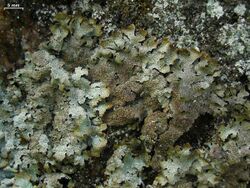Biology:Parmelia saxatilis
| Parmelia saxatilis | |
|---|---|

| |
| Scientific classification | |
| Domain: | Eukaryota |
| Kingdom: | Fungi |
| Division: | Ascomycota |
| Class: | Lecanoromycetes |
| Order: | Lecanorales |
| Family: | Parmeliaceae |
| Genus: | Parmelia |
| Species: | P. saxatilis
|
| Binomial name | |
| Parmelia saxatilis | |
| Synonyms[3] | |
| |
Parmelia saxatilis, commonly known as the salted shield lichen or crottle,[4] is a species of foliose lichen in the family Parmeliaceae. Several morphologically similar species, formerly lumped together, are now distinguished by their DNA.
Taxonomy
It was first described in 1753 by Carl Linnaeus with the name Lichen saxatilis.[5] Erik Acharius transferred it to Parmelia in 1803.[3]
Molecular phylogenetic studies have shown that Parmelia saxatilis is a member of a species complex–a group of morphologically similar but genetically distinct species. P. discordans, P. ernstiae, P. hygrophila, P. imbricaria, P. mayi, P. omphalodes, P. pinnatifida, P. serrana, P. submontana, P. sulymae, and P. rojoi are other members of this complex.[6] In the case of the European members of this complex, there is no reliable set of morphological and chemical characteristics that can be used to distinguish between these species, and therefore DNA analysis is the only reliable way to identify them. This has been demonstrated in studies conducted in Scotland[7] and Italy.[8]
Description
The lichen has a greenish-gray to bluish-gray thallus that can turn brown in exposed locations. It typically grows on rock, although it is sometimes found on bark or wood. Parmelia saxatilis is used to make dyes with deep red-brown and rusty-orange colors.[4] Known as "crotal" in Scotland, it was used to dye traditional cloths including Harris tweed.[9][10] A somewhat similar species complex with a cosmopolitan distribution is the Parmelia sulcata group, generally growing on trees.
Conservation
In 2021, Parmelia saxatilis was assessed for the global IUCN Red List. Because the lichen is common, abundant, and widely distributed with a stable population size, it is considered of least concern.[1]
References
- ↑ Jump up to: 1.0 1.1 Yahr, R.; Allen, J.; Lymbery, C.; Batallas-Molina, R.; Bungartz, F.; Dal Forno, M.; Howe, N.; Lendemer, J. et al. (18 May 2021). "Parmelia saxatilis". The IUCN Red List of Threatened Species 2021. https://www.iucnredlist.org/species/194660573/194678129.
- ↑ Acharius E. (1803) (in la). Methodus qua Omnes Detectos Lichenes Secundum Organa Carpomorpha ad Genera, Species et Varietates Redigere atque Observationibus Illustrare Tentavit Erik Acharius. Stockholm: Ulrich. p. 204.
- ↑ Jump up to: 3.0 3.1 "Synonymy: Parmelia saxatilis (L.) Ach". Species Fungorum. CAB International. http://www.speciesfungorum.org/Names/SynSpecies.asp?RecordID=398223.
- ↑ Jump up to: 4.0 4.1 Lichens of North America. New Haven and London: Yale University Press. 2001. p. 483. ISBN 978-0-300-08249-4.
- ↑ Linnaeus, Carl (1753) (in la). Species Plantarum. 2. Stockholm: Impensis Laurentii Salvii. p. 1142. https://www.biodiversitylibrary.org/page/26069113.
- ↑ Crespo, Ana; J. Rico, Víctor; Garrido, Elisa; Lumbsch, H. Thorsten; Divakar, Pradeep K. (2020). "A revision of species of the Parmelia saxatilis complex in the Iberian Peninsula with the description of P. rojoi, a new potentially relict species". The Lichenologist 52 (5): 365–376. doi:10.1017/S0024282920000341.
- ↑ Corsie, Eleanor I.; Harrold, Paul; Yahr, Rebecca (2019). "No combination of morphological, ecological or chemical characters can reliably diagnose species in the Parmelia saxatilis aggregate in Scotland". The Lichenologist 51 (2): 107–121. doi:10.1017/S0024282919000069.
- ↑ Beatrice Castellani, Maria; Bianchi, Elisabetta; Coppi, Andrea; Nascimbene, Juri; Benesperi, Renato (20 July 2021). "Revision of the Parmelia saxatilis group in Italy based on morphological, chemical, and molecular data". Phytotaxa 512 (1). doi:10.11646/PHYTOTAXA.512.1.2.
- ↑ Fraser, Jean: Traditional Scottish Dyes, Canongate, 1983
- ↑ J.C.T. Uphof, Dictionary of Economic Plants, Hafner, New York, p. 210, cited at Bibliographical database of the human uses of lichens retrieved 20 May 2007
Wikidata ☰ Q2053697 entry
 |


